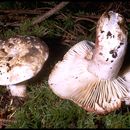Associations
provided by BioImages, the virtual fieldguide, UK
In Great Britain and/or Ireland:
Fungus / parasite
fruitbody of Asterophora lycoperdoides parasitises decayed fruitbody of Russula nigricans
Remarks: season: summer-autumn
Other: major host/prey
Fungus / parasite
fruitbody of Asterophora parasitica parasitises moribund fruitbody of Russula nigricans
Other: major host/prey
Fungus / parasite
colony of Calcarisporium anamorph of Calcarisporium arbuscula parasitises fruitbody of Russula nigricans
Other: minor host/prey
Fungus / saprobe
sessile sporodochium of Myrothecium anamorph of Myrothecium inundatum is saprobic on decaying fruitbody of Russula nigricans
Foodplant / mycorrhiza / ectomycorrhiza
fruitbody of Russula nigricans is ectomycorrhizal with live root of Tilia
Other: unusual host/prey
Foodplant / mycorrhiza / ectomycorrhiza
fruitbody of Russula nigricans is ectomycorrhizal with live root of Fagus
Remarks: Other: uncertain
Other: major host/prey
Foodplant / mycorrhiza / ectomycorrhiza
fruitbody of Russula nigricans is ectomycorrhizal with live root of Quercus
Remarks: Other: uncertain
Other: major host/prey
Foodplant / mycorrhiza / ectomycorrhiza
fruitbody of Russula nigricans is ectomycorrhizal with live root of Salix repens
Remarks: Other: uncertain
Other: unusual host/prey
Comprehensive Description
provided by North American Flora
Russula nigricans (Bull.) Fries, Syst. Myc. 1: 60. 1821
Agaricus nigricans Bull. Herb. Fr. pL 212. 1784. Agaricus nigrescens Krombh. Abbild. 9: 27. 1845.
Pileus convex and umbilicate, expanding and centrally depressed, 7-13 cm. broad; surface pure-white or stained with smoky-brown, becoming blackish or dark-fuliginous, slightly viscid when wet, glabrous ; margin inciurved at first, even : context firm, white, slowly changing to reddish where wounded and becoming black, mild to the taste, without odor; lamellae white, becoming blackish with age or in drying, unequal, slightly rounded at the inner ends and adnexed, broad, subdistant; stipe white, becoming smoky-brown with age, solid, 6 cm. long, reaching 3 cm. thick: spores white, broadly elliptic, very finely echinulate, 7 X 8.7 m-
Type IvOcality: France.
Habitat: On the ground in coniferous or mixed woods, in rather dry soil.
Distribution: Maine to Virginia and North Carolina and west to Wisconsin and Oregon; also in Europe.
IlIvUSTrations : Barla, Champ. Nice pi. 17, f. 1-9 (as Agaricus adustus Pers.); Bull. Herb. Fr. pi. 212, 579, f. 2; Cooke, Brit. Fungi pL 1015; Gill. Champ. Fr. pi. 625: Hussey, 111. Brit. Myc. 1: pi. 73 (as Agaricus adustus) ; Krombh. Abbild. pi. 70, f. 14. 15; Qu61. Champ. Jura Vosg. pi. 12, f. 1; Richon & Roze, Atl. Champ: pi. 41, f. 19-22; Ricken, Blatterp. Deutschl. pi. 15, f. 2; 3vanzi, Funghi Mang. pi. 51, f. 2, a, b, c; Sow. Engl. Fungi pi. 36 (as Agaricus elephantinus) .
4. Russula densifolia (Seer.) Gill. Champ. Fr. 231. 1876.
Agaricus adustus densifolius Seer. Mycogr. Suisse 1: 476. 1833.
Pileus fleshy, firm, convex, then depressed, up to 10 cm. broad; surface white, then fuliginous, gray, or smoky-brown, viscid when wet, glabrous; margin even, inflexed for some time: context white, then reddish where wounded and at length black, mild, without special odor; lamellae white, reddish, then black where wounded, unequal, some forking, adnate to decurrent, close; stipe white, then sordid to gray, at length blackening, firm, slightly pniinose, 4 cm. long, up to 2.5 cm. thick: spores white, globose, 7-8 ij. in diameter.
Type locality: France. Habitat: On the ground in mixed woods.
Distribution: Vermont to the District of Columbia and west to Michigan; also in Europe.
- bibliographic citation
- William Alphonso MurrilI, Gertrude Simmons BurIingham, Leigh H Pennington, John Hendly Barnhart. 1907-1916. (AGARICALES); POLYPORACEAE-AGARICACEAE. North American flora. vol 9. New York Botanical Garden, New York, NY
Comprehensive Description
provided by North American Flora
Russula eccentrica Peck, Bull. N. Y. State Mus. 150: 61. 1911
Pileus fleshy but thin, eccentric or deformed, at first centrally depressed, becoming nearly plane, 5-10 cm. broad; surface brownish or brownish-gray, faintly reddish-brown when dry, glabrous, dry; margin even, incurved at first and for some time: context white, with disagreeable odor; lamellae pallid or tinged with pink, becoming reddish where wounded, unequal, adnate or adnexed, thin, subdistant, broad; stipe white, equal, smooth, spongy within, 4r-6 cm. long, 1.5-3 cm. thick: spores white, subglobose, smooth or nearly so, 5-7 X 6-8 ju.
Type locaI/ITy: Near St. Louis, Missouri. Habitat: In a grassy ravine in open oak woods. Distribution: Known only from the type locality.
- bibliographic citation
- William Alphonso MurrilI, Gertrude Simmons BurIingham, Leigh H Pennington, John Hendly Barnhart. 1907-1916. (AGARICALES); POLYPORACEAE-AGARICACEAE. North American flora. vol 9. New York Botanical Garden, New York, NY
Russula nigricans: Brief Summary
provided by wikipedia EN
Russula nigricans, commonly known as the blackening brittlegill or blackening russula, is a gilled mushroom found in woodland in Europe. It gains both its common and scientific name from its propensity to turn black from cutting or bruising.
- license
- cc-by-sa-3.0
- copyright
- Wikipedia authors and editors

